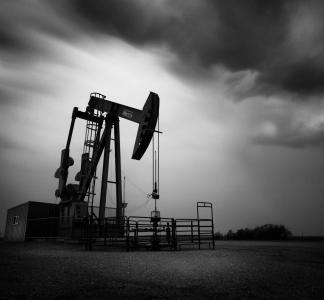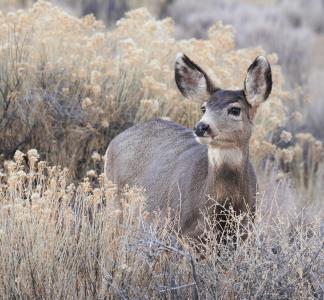4 ways oil and gas drilling is bad for wildlife

A group a pronghorn antelope in Cuerda de Lena ACEC, AZ
Mason Cummings/TWS
Despite misinformation, evidence shows that development on public lands harms wildlife.
For decades, the federal government has largely treated public lands as a source of oil, gas and other finite resources. Only recently has the government begun to reevaluate its practices make conservation a bigger priority. But while progress has been made, the consequences remain.
The fact of the matter is that oil and gas projects harm North American wildlife. Though industry interests claim all is fine—one Congressional Republican, for example, insists without evidence that caribou love oil pipelines—wildlife populations are decreasing at an alarming rate: Just this year the U.S. Fish and Wildlife Service declared 21 more species extinct.
While there are countless causes for population decline and we can’t blame any single threat, the role of the oil and gas industry is undeniable. Here are a few ways oil and gas development projects pose a major danger to wildlife.
-
Oil and gas drilling drives the climate crisis
The most obvious way oil and gas threatens wildlife is by producing the planet-cooking emissions that accelerate the climate crisis. Though climate change danger may seem far off, the impacts are already here and worsening rapidly. Just this year, the World Meteorological Society warned that unprecedented temperatures and extreme weather events were being observed across the planet.
These changes have a devastating effect on wildlife. Shifting climates radically alter habitats; tropical plants, for example, are now found further and further north. Meanwhile, abnormally destructive events like extreme wildfires and hurricanes devastate entire landscapes. As habitats rapidly change, wildlife are forced to move or face annihilation. According to one 2020 study, one-third of all animal and plant species on Earth could face extinction by 2070 due to climate change.
-
Oil and gas drilling destroys habitat and disrupts migration
While some creatures like urban pigeons or raccoons can easily adapt to human development, many wildlife need undeveloped natural habitat to survive. Migrating animals especially rely on large tracts of intact landscapes to traverse safely and find resources they need. When oil and gas projects with well pads, fences, pipelines and roads—not to mention nearly constant noise and light pollution—chop up a landscape, wildlife have less safe space to thrive and are forced into more dangerous areas.
And despite deceitful industry claims that wildlife are indifferent or even attracted to oil and gas projects, studies have shown that wildlife have a strong aversion to project infrastructure. In Wyoming, for example, one study found that mule deer avoided areas they previously frequented after well pads were built. Even in cases where efforts were made to remediate and mitigate the impact of development, wildlife populations have still suffered.
-
Oil and gas drilling make the air and water filthy
Equally problematic is the damaging effect that oil and gas projects have on local air and water. No matter the method used, oil and gas extraction is not clean or easy: Drilling kicks up heavy metals, toxic particulates and volatile compounds that pollute land, air and water. Studies have found significant concentrations of pollutants in air downwind of oil and gas wells that have been linked to serious health complications in humans. At the same time, these operations generate millions of gallons of polluted wastewater that can leech into surface and groundwater when improperly treated or disposed of.
-
Oil and gas drilling inevitably lead to spills and accidents
As if “routine” pollution weren’t bad enough, oil and gas production accidents pose an even greater threat. In the all-too-common event of a serious incident, the damage done to the natural environment can be catastrophic and permanent. Leaking oil and dangerous waste byproducts poison ecosystems and injure wildlife, while chemical dispersants used to breakdown oil slicks may themselves be toxic. These events—even “small” spills—can be ruinous.
In the Gulf of Mexico, for example, wildlife populations are continuing to struggle—more than 10 years after the Deepwater Horizon explosion. Estimates now suggest that millions of birds, dolphins, turtles and other wildlife have been killed by the disaster itself or its lingering impacts. Many of those are species that are already critically threatened, like Atlantic ridley sea turtles.
Tighter restrictions on federal oil and gas leasing can help vulnerable wildlife.
These threats have led to intense scrutiny of the land-leasing practices of the U.S. Bureau of Land Management (BLM). The agency manages 245 million acres of public lands, including some areas widely considered among the most ecologically important in the nation For example, 53% of BLM lands in Colorado are critical habitat for wild elk. Despite this—and despite the agency’s chartered mission to manage lands for multiple uses—analysis has shown that over 90% of BLM lands in Colorado are open for oil and gas development.
Recently, a legal clash between the state government and BLM forced the agency to reevaluate its oil and gas leasing and management practices in Colorado. Instead of using this opportunity to make meaningful and lasting change, however, the agency’s resulting plan takes a loophole-filled reactionary approach that would focus on “mitigating” harm instead of avoiding it in the first place. This news comes shortly after experts warned that local elk populations may not be sustainable.
With extinction rates climbing and the climate crisis intensifying, bold steps must be taken now to protect wildlife and the natural world at large. Though officials claim to understand the urgency of the moment, concrete actions like the Colorado plan have yet to meet expectations.



